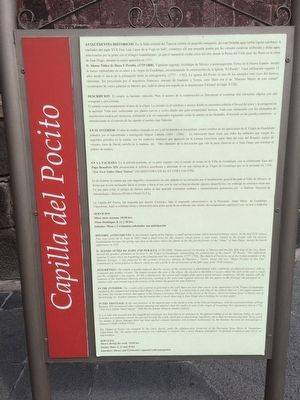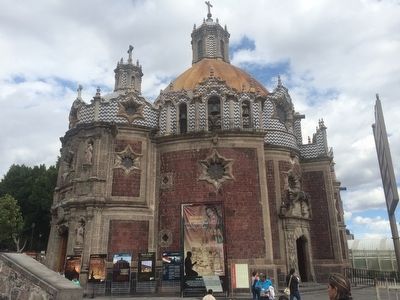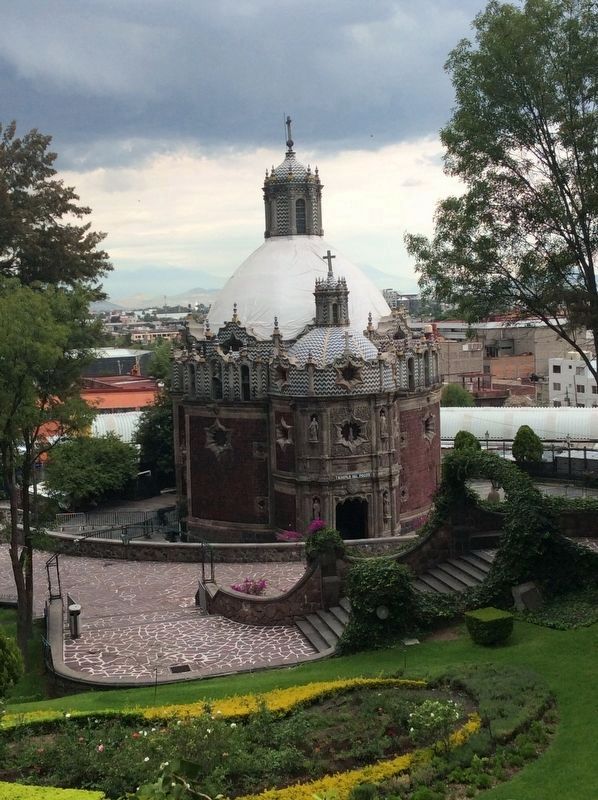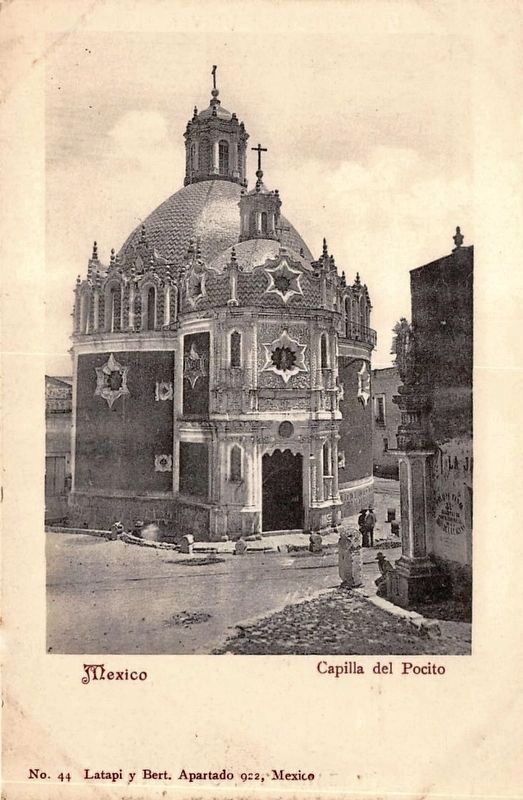Colonia Villa Gustavo A. Madero in Ciudad de México, Mexico — The Valley of Mexico (The Central Highlands)
Chapel of the Well
Capilla del Pocito
Antecedentes Historicos: En la falda oriental del Tepeyac existía un pequeño manantial, del cual brotaba agua turbia (aguas salobres). A mediados del siglo XVII Fray Luis Lasso de la Vega en 1647, construyo allí una pequeña ermita por las virtudes curativas atribuidas a dicha agua, relacionadas por la gente con el milagro Guadalupano, ya que el manantial estaba cerca del sitio donde la Reina del Cielo puso las flores en la tilma de Juan Diego, durante la cuarta aparición en 1531.
D. Alonso Núñez de Haro y Peralta, (1792-1800). Vigésimo segundo Arzobispo de México y quincuagésimo Virrey de la Nueva España mostró la mayor esplendidez de su amor a la virgen de Guadalupe, encomendando la construcción de la Iglesia “El Pocito”. Cuya edificación requirió 15 años desde el inicio de la planeación hasta su consagración, (1777-1792). La iglesia del Pocito es uno de los ejemplos más ricos del barroco mexicano, fue proyectado por el arquitecto Francisco Antonio de Guerrero y Torres, cuyo título era el “Maestro Mayor de esta ciudad” (constructor de varios palacios en México que, todavía ahora son orgullo de la arquitectura Virreinal del siglo XVIII).
Descripcion: El templo es bastante reducido. Pero el acierto de la construcción es fenomenal al combinar una estructura elíptica con una octagonal y otra circular.
El templo ocupa propiamente el área de la elipse. La circular es el vestíbulo o acceso donde se encuentra todavía el brocal del pozo y la octagonal es la sacristía. Todo esto conformado por planos curvos y rectos dando una gran complejidad barroca. Todo esto enmarcado con los elementos de arquitectura tradicional mexicana, trabajando a la vez materiales regionales como la cantera en las fachadas, el tezontle en las paredes exteriores e introduciendo en el exterior de las cúpulas el azulejo tipo Talavera.
En su interior: El altar de madera chapada en oro y en las paredes se encuentran cuatro retablos de las apariciones de la Virgen de Guadalupe pintados por el renombrado y distinguido Miguel Cabrera (1695-1768). Es interesante hacer notar que todos los símbolos que cargan los angellilos pintados en la cúpula, son los símbolos marianos que aparecen en la Letanía Lauretana, parte final del rezo del Rosario: espejo de virtudes, torre de David, estrella de la mañana, etc. Otro elemento de la decoración que vale la pena observar es el Juan Diego que sostiene el púlpito de madera.
En la fachada: En la entrada poniente, en su parte superior está el escudo de armas de la Villa de Guadalupe, con la celebrísima frase del Papa Benedicto XIV pronunciada al referirse asombrado y admirado al ver una replica de la Virgen de Guadalupe que se le presentó en 1754: “Non Fecit Taliter Omni Nationi” (No hizo cosa igual en otra nación).
Es de tomarse en cuenta que este magnífico monumento ha sido dañado en su estructura por el hundimiento general de todo el Valle de México, de forma que se está inclinando hacia el oriente y hacia el sur, con lo cual se han producido algunos desperfectos; sin embargo no amenaza ruina aún. Ya que para evitar el peligro de futuros daños se han aplicado constantes medidas y mantenimiento pertinentes por el Instituto Nacional de Antropología e Historia (INAH-CONACULTA).
La Capilla del Pocito, fue asignada por decreto Canónigo, bajo el resguardo administrativo de la Parroquia Santa María de Guadalupe – Capuchinas. Aquí se celebran misas y ceremonias para quien gusta de un ambiente más íntimo, de recogimiento espiritual y rico en arte y tradición.
Servicios:
Misas entre semana: 18:00 hrs.
Misas Domingos: 8, 11 y 18 hrs.
Sábados: Misas y Ceremonias solicitadas con anticipación
Historic Antecedents: In the oriental región of the Tepeyac a small spring existed, which bursted turbulent waters. In the mid XVII century Fray Luis Lasso de la Vega in 1647, built a small town for the curative virtues given to such water, related by the people with the miracle Guadalupano because the spring was close to the place where the Queen of the Sky put the flowers in the “tilma” of Juan Diego, during the fourth appearance in 1531.
D. Alonso Nuñez de Haro and Peralta, (1729-1800). Twenty-second Archbishop of Mexico and the fifty fifth King of New Spain showed the greatest splendour of his love to the Virgen of Guadalupe, commending the construction of the Church “El Pocito.” The edification required 15 years since the beginning of the planning until the consecration, (1777 1792). The church of Pocito is one of the richest examples of the Mexican baroque, it was projected by the architect Francisco Antonio de Guerrero y Torres, whose title was “Major Teacher of this City” (constructor of varies palaces in Mexico which are still a pride to the architecture of the fifth reign of the XVIII century).
Description: The temple is greatly reduced. But the success of the construction is phenomenal when combining an elliptical structure with an octagonal and another circular. The temple occupies the area of the ellipse, the circular is the lobby or access where the curb of the well is found and the octagonal is the sacristy. All this conformed by the curved and straight plans gave a great baroque complexity. All this marked with the elements of the traditional Mexican architecture, working at the same time regional material like the quarry in the frontage, the pavement in exterior walls and introducing in the exterior of the domes the glazed tile type Talavera.
In the interior: The wooden altar covered in gold and in the walls there are four altar pieces of the apparitions of the Virgen of Guadalupe painted by the renamed and distinguished Miguel Cabrera (1695 1768). It is interesting to note that all the symbols that car y the angels painted in the dome, are marian symbols that appear in the Letania Lauretana; final part of the prayer of the Rosary: mirror of virtues, tower of David, star of the morning, etc. Another element of the decoration that is worth observing is Juan Diego who is holding the wooden pulpit.
In the frontage: In the west entrance, in the superior part is the shield of arms of the Villa de Guadalupe, with the celebrated phrase of Pope Benedict XIV pronounced when referred amazing and admired when the replica is seen of the Virgen of Guadalupe that appeared to him in 1754: “Non Fecit Taliter Omni Nationi” (Did Not Do Similiar Things In Another Nation).
It is to take into account that this magnificent monument has been hurt in its structure by the general sinking of all the Mexican Valley, in such a form that it is inclining towards the east and towards the south, which has produced many imperfects: but it does not threaten any ruin. Yet to avoid the danger of future damages there has been applied constant measures and pertinent maintenance by the Instituto Nacional de Antropologia e Historia (INAH CONACULTA).
Services:
Masses during the week: 18:00 hrs
Sunday Mass: 8, 11 and 18 hrs
Saturdays: Masses and Ceremonies requested with anticipation
Topics. This historical marker is listed in these topic lists: Churches & Religion • Man-Made Features. A significant historical year for this entry is 1647.
Location. 19° 29.125′ N, 99° 6.901′ W. Marker is in Ciudad de México. It is in Colonia Villa Gustavo A. Madero. Marker can be reached from Calzada de Guadalupe close to Zumarraga. The marker is on the south side of the Chapel of the Well at the Shrine of the Virgin of Guadalupe. Touch for map. Marker is in this post office area: Ciudad de México 07050, Mexico. Touch for directions.
Other nearby markers. At least 8 other markers are within 5 kilometers of this marker, measured as the crow flies. José María Morelos y Pavón Stopped to Pray Here (within shouting distance of this marker); The Parish of the Natives (within shouting distance of this marker); The Banner of Atotonilco and the Parish of the Natives (about 90 meters away, measured in a direct line); The Virgin of Guadalupe and Juan Diego (about 120 meters away); Tepeyac Chapel (about 120 meters away); Francisco Primo de Verdad y Ramos (about 180 meters away); The Pilgrim's Route (approx. 2.9 kilometers away); The Pulque Customs House (approx. 4.1 kilometers away). Touch for a list and map of all markers in Ciudad de México.
Credits. This page was last revised on April 17, 2020. It was originally submitted on January 13, 2016, by J. Makali Bruton of Accra, Ghana. This page has been viewed 660 times since then and 50 times this year. Photos: 1, 2. submitted on January 14, 2016, by J. Makali Bruton of Accra, Ghana. 3. submitted on July 15, 2017, by J. Makali Bruton of Accra, Ghana. 4. submitted on December 12, 2017.



